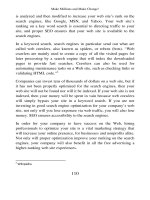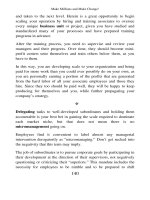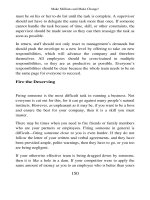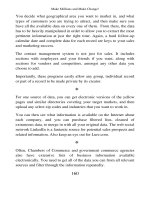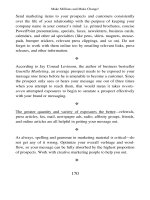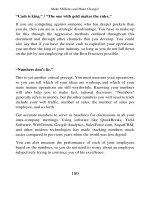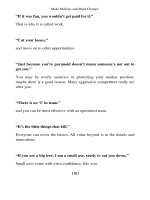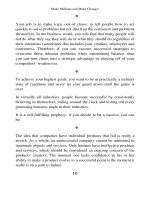China constructing capitalism economic life and urban change
Bạn đang xem bản rút gọn của tài liệu. Xem và tải ngay bản đầy đủ của tài liệu tại đây (14.68 MB, 345 trang )
‘The ongoing transformation of China is cultural and spatial as much as economic
and political. This remarkable book brings all these dimensions together and
integrates them into a coherent theoretical framework supported by empirical
observation. A must-read for everybody interested in the scholarly analysis of
China, as well as cutting edge contributions in cultural theory.’
Manuel Castells,Wallis Annenberg Chair of Communication Technology and Society,
University of Southern California
‘Scott Lash, Michael Keith and colleagues have an entirely original understanding
of China which makes this book rare, relevant and new.’
Rem Koolhaas, Founding Partner, Office of Metropolitan Architecture/AMO
‘Is there a China model? Is the economic development in China another version
of neoliberalism or a socialist market economy? The authors of this book develop
their argument that China is constructing its own version of capitalism by
combining broad historical observations and sophisticated theoretical analysis.This
is an inspiring intervention in the ongoing debate on China’s past, present and
future.’
Wang Hui, author of China’s New Order, The Politics of Imagining Asia and
The End of the Revolution
This page intentionally left blank
CHINA CONSTRUCTING CAPITALISM
The GDP of China has been growing at over ten per cent annually since 1978, but
this has only come to widespread notice in the past decade.
The received wisdom about China has been largely of two types, both of which
– more or less – understand China in the context of neoliberalism. The more
business- or business studies-orientated literature seems to argue that if China does
not adapt the rule of clear and distinct property and contract law – in short, of
Western institutions – its economy will stall.
The second set of voices is more clearly from the left, arguing that the Chinese
economy, and city, is neoliberal. For them, China does not diverge widely from the
Anglo-American model that, from 2008, has brought the world economy to its
knees.
China Constructing Capitalism takes issue with these analyses.The authors argue
that it is not Western neoliberalism that is constructing the Chinese economy, but
instead that China is constructing capitalism anew.The two central theses of their
argument are:
•
•
Economic life – neoliberal economic life is individualised and disembedded,
while the China model is relational and situated.
Urban change – China has created a form of ‘local state capitalism’, which
stands in contrast to neoliberal versions of the city.
This book analyses China as a ‘risk culture’, examining, among other factors,
Chinese firms and political ties, property development, migrant urbanisms and
share-trading rooms. It scrutinises the ever-present shadow of the risk-averse (yet
uncertainty-creating) state. China Constructing Capitalism is a must-read for social
scientists, policy-makers and investors.
Michael Keith is Director of the Centre on Migration, Policy and Society and holds
a personal chair in the Department of Anthropology at the University of Oxford.
Scott Lash is Professor of Sociology and Director of the Centre for Cultural
Studies at Goldsmiths College, University of London.
Jakob Arnoldi is Professor at Aarhus University, School of Business and Social
Sciences, Department of Business Administration. He is also affiliated with the
Sino-Danish Center for Education and Research.
Tyler Rooker is Lecturer in Contemporary Chinese Studies at the University of
Nottingham.
International library of sociology
Founded by Karl Mannheim
Editor: John Urry, Lancaster University
Recent publications in this series include:
Risk and Technological Culture
Towards a sociology of virulence
Joost Van Loon
The Culture of Exception
Sociology facing the camp
Bülent Diken and Carsten Bagge Laustsen
Reconnecting Culture, Technology
and Nature
Mike Michael
Visual Worlds
John Hall, Blake Stimson and
Lisa Tamiris Becker
Advertising Myths
The strange half lives of images
and commodities
Anne M. Cronin
Time, Innovation and Mobilities
Travel in technological cultures
Peter Frank Peters
Adorno on Popular Culture
Robert R.Witkin
Consuming the Caribbean
From arkwarks to zombies
Mimi Sheller
Between Sex and Power
Family in the world, 1900–2000
Goran Therborn
States of Knowledge
The co-production of social science
and social order
Sheila Jasanoff
After Method
Mess in social science research
John Law
Brands
Logos of the global economy
Celia Lury
Complexity and Social
Movements
Multitudes acting at the edge of chaos
Ian Welsh and Graeme Chesters
Qualitative Complexity
Ecology, cognitive processes and the
re-emergence of structures in
post-humanist social theory
Chris Jenks and John Smith
Theories of the Information
Society, 3rd Edition
Frank Webster
Crime and Punishment in
Contemporary Culture
Claire Grant
Mediating Nature
Nils Lindahl Elliot
Haunting the Knowledge
Economy
Jane Kenway, Elizabeth Bullen,
Johannah Fahey and Simon Robb
Global Nomads
Techno and new age as transnational
countercultures in Ibiza and Goa
Anthony D’Andrea
The Cinematic Tourist
Explorations in globalization, culture
and resistance
Rodanthi Tzanelli
Non-Representational Theory
Space, politics, affect
Nigel Thrift
Urban Fears and Global Terrors
Citizenship, multicultures and
belongings after 7/7
Victor J. Seidler
Sociology through the Projector
Bülent Diken and Carsten Bagge Laustsen
Multicultural Horizons
Diversity and the limits of the civil
nation
Anne-Marie Fortier
Social Transationalism
Steffen Mau
Towards Relational Sociology
Nick Crossley
Mobile Lives
Anthony Elliott and John Urry
Stillness in a Mobile World
David Bissell and Gillian Fuller
Unintended Outcomes of Social
Movements
The 1989 Chinese student movement
Fang Deng
Revolt, Revolution, Critique
The paradox of society
Bulent Diken
Travel Connections
Tourism, technology and togetherness
in a mobile world
Jennie Germann Molz
Mobility, Space and Culture
Peter Merriman
Transforming Images
Screens, affect, futures
Rebecca Coleman
Sound Moves
IPod culture and urban experience
Michael Bull
Staging Mobilities
Ole B. Jensen
Jean Baudrillard
Fatal theories
David B. Clarke, Marcus A. Doel,
William Merrin and Richard G. Smith
China Constructing Capitalism
Economic life and urban change
Michael Keith, Scott Lash, Jakob Arnoldi
and Tyler Rooker
Aeromobilities
Theory and method
Saulo Cwerner, Sven Kesselring and
John Urry
This page intentionally left blank
CHINA CONSTRUCTING
CAPITALISM
Economic life and urban change
Michael Keith, Scott Lash, Jakob Arnoldi
and Tyler Rooker
First published 2014
by Routledge
2 Park Square, Milton Park,Abingdon, Oxon OX14 4RN
and by Routledge
711 Third Avenue, New York, NY 10017
Routledge is an imprint of the Taylor & Francis Group, an informa business
© 2014 Michael Keith, Scott Lash, Jakob Arnoldi and Tyler Rooker
The right of Michael Keith, Scott Lash, Jakob Arnoldi and Tyler Rooker to be
identified as authors of this work has been asserted by them in accordance with
sections 77 and 78 of the Copyright, Designs and Patents Act 1988.
All rights reserved. No part of this book may be reprinted or reproduced
or utilised in any form or by any electronic, mechanical, or other means,
now known or hereafter invented, including photocopying and recording,
or in any information storage or retrieval system, without permission in
writing from the publishers.
Trademark notice: Product or corporate names may be trademarks or
registered trademarks, and are used only for identification and
explanation without intent to infringe.
British Library Cataloguing in Publication Data
A catalogue record for this book is available from the British Library
Library of Congress Cataloging-in-Publication Data
Keith, Michael, 1960China constructing capitalism : economic life and urban change /
Michael Keith, Scott Lash, Jakob Arnoldi and Tyler Rooker. -- First Edition.
pages cm. -- (International library of sociology)
Includes bibliographical references and index.
ISBN 978-0-415-49705-3 (hardback) -- ISBN 978-0-415-49706-0 (pbk.)
-- ISBN 978-0-203-87739-5 (ebook) 1. China--Economic policy-21st century. 2. Urban policy--China. I.Title.
HC427.95.K457 2013
330.951--dc23
2013007421
ISBN: 978-0-415-49705-3 (hbk)
ISBN: 978-0-415-49706-0 (pbk)
ISBN: 978-0-203-87739-5 (ebk)
Typeset in Bembo
by FiSH Books Ltd, Enfield
CONTENTS
List of illustrations
Acknowledgements and dedication
Introduction: China versus neoliberalism
x
xii
1
1
Chinese thought, cultural theory
32
2
Connections, networks, culture: the institutions of Chinese
capitalism
54
Relational property and urban temporality: China’s urbanism
in the city of experts
72
4
Local state capitalism? From urban hierarchy to city markets
112
5
Chinese firms and political ties
140
6
Property development: markets and districts
151
7
Trading ethnographies: stuck in China
180
8
Knowing but not doing: the financial sector in China and
institutional reform
205
Risk cultures: production of Shanghai space
223
3
9
10 Shenzhen dwelling: arrival and migrant urbanisms
247
Conclusions: China and the neoclassical subject
275
Notes
Bibliography
Index
290
296
325
LIST OF ILLUSTRATIONS
Figures
2.1
3.1
3.2
3.3
3.4
3.5
3.6
3.7
3.8
3.9
4.1
4.2
4.3
4.4
4.5
4.6
4.7
6.1
An example of how different government and party agencies exert
control over a local government-controlled business group
China Central Television (CCTV) building caricature, 798 Gallery,
Beijing
China Central Television building Beijing, designed by OMA, Ole
Scheeren and Rem Koolhaas
‘Can I wake up from this dream?’ Beijing 798, representation
of Beijing’s new China Central Television building
Views inside Shanghai’s Jin Mao Tower
Financial Times advertisement: ‘The generic city’
The ‘real view’ from the Bund to Pudong
Guangzhou Tulou ‘social housing’ development
Images of Guangzhou Tulou ‘social housing’ development
Alternative views of China’s new capitalism
The marketing motif fuses a Venetian carnival mask to its cousin
from China
Marketing showroom, ‘Italian Town’, Shanghai
‘Faux canalside’, Italian Town, Shanghai
Xiaoqu marketing suite, Shanghai
Xiaoqu marketing suite, Shenzhen
‘Green town’ marketing motif, Shanghai Real Estate Trade
Convention, 2008
‘Dahua’ real estate investments in Shanghai, Shanghai Real Estate
Trade Convention, 2009
Development flowchart
58
95
96
96
97
98
98
102
103
110
129
129
131
133
134
135
136
166
List of illustrations xi
7.1
7.2
7.3
7.4
7.5
Shanghai Index, 2006–2008
Da-xiao fei and stock citizens
View of a trading room in Pudong, Shanghai
Old Qiu’s trading room terminal, claimed by him every day
China Merchants Bank CMP1 put warrant trading on
15 August 2007
7.6 Risk-awareness campaign at the trading room
10.1 Shenzhen Districts (Shenzhen City Government)
10.2 Images of Dafen cun
10.3 Xiasha cun panorama (civillagety)
185
190
193
194
200
202
263
266
268
Tables
4.1
4.2
4.3
5.1
6.1
6.2
6.3
7.1
7.2
7.3
8.1
10.1
10.2
10.3
10.4
Scale and population of Shanghai districts
Top 10 Development Companies in China 2005 by assets
Top 10 Real Estate Companies in China
Regression predicting return on assets in listed Chinese firms
Average GDP over selected years – Shanghai, Jing’an, Yangpu,
Minhang
Shanghai urban property rights structure (per 100 Houses)
Summary of 500 random third-phase transactions of Minhang
Real’s Beautiful Capital xiaoqu
Shanghai and Shenzhen issued versus floating values
Recent Shanghai and Shenzhen market index values
Stock terms for sanhu
Turnover Chinese foreign exchange market
Changes in Shenzhen’s resident and temporary resident
populations, 1979–2000 (10,000 persons)
Terms used to refer to migrants entering the city to work
Population by hukou (2007)
Migrants’ origins, by place and percentage
126
130
132
148
153
154
178
187
188
198
209
253
254
255
256
ACKNOWLEDGEMENTS AND
DEDICATION
This volume represents the cumulative effort of the full team of authors over a long
time. It has a biography of almost ten years, inspired by happenstance and
serendipity as much as the attempt to synthesise scholarship from both China and
the West and thinking from disciplines across the social sciences. There are consequently many debts incurred in the translating of a major research project into
an academic monograph. One of the authors (Rooker) had been doing intensive
research in China since the early 1990s. But in a sense the book started when
another one of us (Lash) was asked to come to China by the architect Rem
Koolhaas to work on a bid to write the conceptual masterplan for the 2010
Shanghai Expo.This was around Christmas 2002 when the Office for Metropolitan
Architecture was about to build the controversial China Central Television
(CCTV) building. Here we encountered Shanghai architect and now USC Dean
Ma Qingyun. Both Koolhaas and Ma have fed our work with thoughts, arguments
and ideas. By 2004, Lash, Keith and Arnoldi had joined to put together a proposal
for research in China. And we are grateful that a Shanghai base for five years was
subsequently supported by the UK Economic and Social Research Council
(ESRC) World Economy and Finance Programme (WEF).We would like to thank
the ESRC – and WEF Programme director John Driffill – for their very generous
support of the project, which made this book possible. The project was entitled
‘Risk Culture in China: An Economic Sociology’. Harrison White, whom we
would also like to thank, inspired this proposal.The focus was further supported by
the ESRC’s funding of a small grant that developed some of the links between
social relationality and economic externalities in an ESRC ‘Rising Powers’ research
network that linked China colleagues with thinkers in Delhi, Mumbai and
Bangalore, principally through the good offices of Ravi Sundaram and his
colleagues at Sarai (in the Centre for the Study of Developing Societies in Delhi)
but also through the committed and thoughtful contributions of Sandeep Kapur,
Acknowledgements and dedication xiii
Will Davies and Li Shiqiao and other participants contributing to events in Beijing,
Delhi and London including John Urry, Geoff Mulgan, Maliq Simone, Saskia
Sassen and Martin Wolf. Tyler Rooker joined us early on as project Research
Associate. He has been the motor of all of this research and has also joined us as
co-author. In 2005, a Royal Society of the Arts trip to Guangdong with artists such
as Jeremy Deller, brought us into contact with Jiang Jun and Doreen Heng Liu,
who have had a fundamental impact on this book.Through Heng Liu, we came to
engage with Shenzhen architects Liu Xiaodu and MengYan, and curator Ou Ning
and with their collaboration gained a great deal from presenting urban strands of
the work at successive architecture biennales in Hong Kong and Shenzhen. Jiang
Jun, editor at the time of the hothouse journal Urban China, invariably gave generously of his time and contacts throughout and we have spent many days together
in the urban spaces of Chongqing, Tianjin and Shenzhen. In 2003 Mike Featherstone of Theory, Culture & Society brokered an introduction to Wang Xioaming.
Wang’s Shanghai University Centre for Contemporary Cultural Studies provided
research assistantship, an institutional base and a forum for intellectual exchange.
Wang introduced us to the Shenzhen Academy of Social Sciences who we worked
integrally with in our urban research in Shenzhen. Wang Xiaoming was also an
entry for us to China’s intellectual left, which had formed around the journal
读书。 Here we met and engaged with Wang Hui, Cui Zhiyuan and Huang Ping,
all of whom gave generously of their time in sharing their ideas.As anyone can see
in this book’s text, Cui’s thinking on property and his personal experience in
Chongqing has been an inspiration. We read this as consistent with Wang’s partly
neo-Confucian understanding of Chinese modernity, which has greatly influenced
the idea of ‘relationality’ in this book. We also want to thank colleagues at the
ESRC Centre on Migration, Policy and Society and particularly Michele Drasdo
for all their support.
In Shanghai, the tutelage, assistance and guidance of Wang Xiaoming was
invaluable. But also his colleagues became both friends and supporters of the
project.The help, solidarity and patience of Yi Yinjoing in supporting the research
and all its problems ultimately made it possible. Further, Jolin, Xiao Shao, Zhu
Shanjie and Yang Ge made life in Shanghai pleasurable and facilitated more than a
few insights. Xu Xiaohong was a touchstone from overseas and David Nieh and
LiuYuyang provided invaluable inside views of the interplay of developers, planners
and architects. Also much appreciation to Kitten Wang, Zeng Biao and Sam Sun.
In addition the help of numerous others facilitated the multi-local nature of
research: in Beijing – Zhu Shanjie, Gao Bingzhong, Michael Pettis, Kou Shuangxiang, Daping, ChenYaling,Yu Laoshi; in Shenzhen – Le Zheng, Chen Chuzhang,
Liu Xiaodu, Meng Yan, Wang Hui (Urbanus), Huang Weiwen; in Wenzhou – Xia
Caiguo; and in Chongqing – Urban China team and UFIDA. Finally, the belief and
ongoing support of Liu Xin and Nancy Chen was crucial to continuing the project
to the end.
Jakob Arnoldi in particular would like to acknowledge financial support received
from the Sino-Danish University Center, which furthered his personal
xiv Acknowledgements and dedication
contribution. He is furthermore grateful for help and assistance from Meng Sun and
Si Liu. He would like to thank Joy Zhang, Chaohong Na and especially Xin Chen
for invaluable input and thought-provoking discussions.Arnoldi owes special thanks
to Anders RyomVilladsen for collaboration and help and for generously letting him
draw on data that was collected jointly. Finally, thanks are due to all the anonymous
interviewees who generously took time to let themselves be interviewed.
Few co-authored books will have featured the level of intense intellectual
exchange and co-working that China Constructing Capitalism has. In this sense we
are all authors of the whole book. But inevitably some chapters are more closely
the work of particular members of the team. Scott Lash was principally responsible
for chapters on the synthesis of China and Western thought, for the risk biographies and much of the conclusion, Jakob Arnoldi for the chapters on economic
institutions, financial development, and political ties. Michael Keith developed the
work on property markets, migration and urban change. Tyler Rooker facilitated
almost all of the fieldwork and conducted the two lengthy ethnographies in the
trading room and through long-term placements in real estate companies. And
finally as with all acknowledgements, if the debts and the contributions were plural
the responsibility for any errors remains with the authors alone. The book is
dedicated to the two children born during the project to Tyler Rooker and his wife
Jasmine – Mia and Ryan – whose births were its greatest outcome, and whose
patience will hopefully be rewarded.
INTRODUCTION
China versus neoliberalism
According to International Monetary Fund estimates, China’s gross domestic
product has grown at an average rate of 9.91% per annum from 1978 to 2012.The
Organisation for Economic Co-operation and Development Economic Outlook
in April 2013 forecasts that China will surpass the US in Gross Domestic Product
(GDP) adjusted for purchasing power parity by 2017. Gross domestic product
projections in the next decade have sharpened this focus. In this context thinking
about China has been largely of two types, both that more or less understand China
in the context of neoliberalism.The first of these is the more business- or business
studies-orientated literature, for example, of Will Hutton (2008) orYasheng Huang
(2005, 2008). This literature seems to argue that if China does not adapt the rule
of law, of clear and distinct property and contract law, in line with Western institutions, that its economy will stall.The second set of voices are more clearly from
the political left – from more academic books in sociology, cultural and urban
studies, such as Mike Davis (2006) in Planet of the Slums, David Harvey (2005) in
his Brief History of Neoliberalism and Aihwa Ong (2006).These voices argue that the
Chinese economy and city – and Davis and Harvey are urbanists – is indeed
neoliberal. For them, however, this is not the solution, but, indeed, the problem.
They argue that China does not diverge widely from the Anglo–American model
that from 2008 has brought the world economy to its knees. It is understandable
that these analysts should think this because in fact China’s not-even-close to
precedented 34-year long-wave of growth coincided with the end of the Cultural
Revolution, the decline of Maoism and the rise of Deng Xiaoping. The rise of
Deng in 1978 neatly coincided with the emergence of the Western neoliberalism
of Margaret Thatcher and Ronald Reagan after their successful elections in 1979
and 1980, respectively. In the West, the rise of Thatcher and Reagan heralded the
demise of social democracy, of some 30 years of social democratic hegemony – in
China the demise of a Communist form of socialism.
2 Introduction
This book takes issue with all of the above analysts. We argue that it is not
Western neoliberalism that is constructing the Chinese economy but instead that
China is constructing capitalism anew.We make this case via two central theses: one
that addresses economic life and the other that is about urban change. The
economic life thesis sets itself up against Western neoclassical economics. It looks
not at the disembedded actor of neoclassical economics but instead at surrounding
economic forms of life, at economic cultures.We can describe this thesis in terms of
eight aspects that effectively constitute it as an ideal type of a sort of ‘China model’
that stands in contrast to a ‘neoliberal model’. Here the neoliberal economic life is
individualised and disembedded while the China model is relational and situated.
The eight aspects of this ideal type are as follows:
1
2
3
4
5
6
7
8
Economic actor or forms of economic life
Rationalism v empiricism
Not performativity
Encountering Weber
Confucianism and Daoism
Internal and external
Property
Risk
Economic life
Economic actor or forms of economic life?
The neoliberal model is rooted in neoclassical economics.The Chinese model stands
opposed to neoclassical economics and its notion of the disembedded economic
actor.This neoclassical model has been performative in constituting a sort of Western
neoliberal economic culture. Whereas neoliberal economic culture features the
disembedded actor, Chinese economic culture privileges not this disembedded goaldirected actor, but the web of economic life that surrounds economic action. Hence
the subtitle of this book is not economic action but economic life.
Rationalism versus ‘empiricism’
The neoclassical economic actor is a rational actor, and here we mean rational
literally in the sense of rationalism. He/she thus takes a set of a priori rules to the
marketplace.This is a Newtonian model, a sort of positivistic model in which time
is reversible, and there is no path dependency. We saw this ‘rationalism’ in the allat-once interventions, with privatisations, public spending cuts and opening of
capital markets that have been so widespread from the 1980s. Here it is a question
of taking a ready-made and disembedded model and applying it as a blueprint.We
saw in the UK under the Thatcher government, and also in Chicago School all-atonce interventions in Russia, Chile and Argentina. China has preferred instead a
Introduction 3
gradualism, a step-by-step process based not on a priori rules, but a more empirical
or better ‘empiricist’, a posteriori process of economic change.
Not performativity
Neoliberal economies have often operated through the performative intervention
of economic theory in material economies. In China, although lip service is given
to such theories, in day-to-day economic activity they are typically non-performative; Chicago School theory or Nobel Prize-winning theories of complex
financial products and do not make the same sort of performative intervention.
Encountering Weber
Sociologists will know that Max Weber’s notion of rational social action is consistent
with the neoclassical economic actor. Weber’s Protestant entrepreneur was similarly
disembedded and transcendental in terms of material life. The Chinese model as
Weber himself noted was based in an amalgam of, not transcendent assumptions of
Protestantism but immanentist Daoism and Confucianism. These still underpin the
Chinese model. But Weber’s China that did not work at the turn of the nineteenth
century seems to be eminently successful at the start of the twenty-first century.
Confucianism and Daoism
From Confucianism, the Chinese model takes not neoliberal individualism, but the
more relational ‘filiality’, i.e. the framework of filial relations between teacher and
student, father and son, etc. It also draws on a secularised form of Confucian rites
and ceremonies. Rites are li (礼, 禮) and gifts are liwu (礼物, 禮物). Wu means
thing: a gift hence is a ‘ritual thing’.What this implies is that secularised economic
life is not just commodity exchange but the superimposition of both gift and commodity exchange. Daoism will oppose to neoclassical economic action its wu wei
of non-action.This wu wei does mean non-action in the sense of the goal-directed,
the subject-verb-object of the rational actor. This actor comes to a situation
purposively, with his aims and objectives already decided. In Mandarin this would
not be wu wei, but you wei (有为).The wu wei points instead to a web of background
activities. So, in Daoism, the you wei of the rational economic actor tends to
dissipate and disintegrate onto this wu wei. Or the transcendental economic actor
disintegrates onto the immanent flux and flow of the wu wei. This flux and flow
instead constitutes a situation: a propensity that itself generates new emerging
forms of economic action.
Internal and external
Neoclassical economics features the individual economic actor or economic
exchange. The unintended consequences of such exchange are understood as
4 Introduction
‘externalities’. Neoliberalism suggests we solve the problem of ‘social costs’ through
well-defined property rights that can internalise these externalities. NeoKeynesians such as Paul Krugman or Joseph Stiglitz will understand them in terms
of the necessity of social goods or public goods. But Krugman and Stiglitz still start
from neoclassical assumptions, i.e. from the ‘internal’ of disembedded actor and
exchange. In the Chinese model you start not from the internal of the economic
actor or exchange but from the externalities themselves, from the forms of life
(from the forms of social and natural life) that surround the exchange.
Property
Neoliberal, well-defined property rights are – almost in a Cartesian sense – ‘clear and
distinct’. Clear and distinct is who and what is included in ownership of such
property and who and what is excluded. This involves a certain ‘unbundling’ of
rights. But even in the Western tradition, property historically involves a ‘bundle of
rights’ involving many claims on use, transfer and enforcement. In China a number
of legal or quasi-legal persons have rights in the same unit of property (Cui 1998)
and it is more common for property rights to be ambiguous as well as plural. The
boundary between what (who) is internal and what (who) is external to a given unit
of property thickens, complexifies, becomes semi-permeable and altogether less
transparent. In this sense property is relational; a Moebius strip rather than a simple
dichotomy of inside and outside. Unbundling individualises property: bundling
makes property relational.
Risk
Non-relational risk in the Western ideal type is individualised. In the China model,
as relational, risk is shared: especially between the generations of a family. Risk is also
shared in long-term guanxi-like business relations.Western-model risk is based again
on a disembedded goal-directed risk-taking social actor. What happens then if we
substitute Daoist assumptions for our Christian and Cartesian prejudices? The
classical actor of Western risk becomes always at the same time in a process of disintegration, of becoming multiple into the flux and flow of the wu wei.This is not the
Western juxtaposition of disordered materiality and ordering transcendental actor. In
the ‘Daoist ethos’ the actor is always involved in a process of becoming immanent and
becoming multiple, hence not very much in control. In place of the Protestant Ethic’s
disordered matter, on the Daoist ethos, matter is always already incipiently ordered as
the propensity of the wu wei in generating new actualities. In the West, as Harrison
White (2002) has observed, markets themselves – even if they are complex metastable
systems – offer entrepreneurs a space of relative security: otherwise they would not
undertake the uncertainty of investment. In China, partly due to seemingly arbitrary
state intervention, markets are not such a basis of relative security. Instead it is the
relationality in the aforementioned web of activities, the partial gift exchange of
guanxi relations that constitute such security.
Introduction 5
China constructing capitalism is also China constructing urbanism. China constructing urbanism again stands in contrast to neoliberal versions of the city. Here
we note six ideal-typical processes that generate a sense of the ‘city as propensity’.
These add up to what can be seen as a single phenomenon, what we call ‘local state
capitalism’.This local state capitalism thesis is about urban change and the six aspects
are as follows:
1
2
3
4
5
6
Local-state private entrepreneurs – real estate
Complex property and experimental governance of relational markets
A step change in flows of capital and labour to the cities
Internal and external – governance autonomies below the level of the national
From danwei to xiaoqu
Hukou, migrants and new instituions of social control
Local state capitalism
Local-state private entrepreneurs – real estate
Of all the relationalities in contemporary China, the pivotal one may be between
the local state and private sector entrepreneurs.This is complex too because often
what look like local state firms are run as private firms, and what look like private
companies have strong local state participation.Very often local government figures
become private entrepreneurs.The relation between local government and private
firms is typically long term, only quasi-contractual. It is a diffuse relation embracing
commodity exchange and gift exchange. It involves guanxi: often the corruption it
comprises is an extension of this guanxi.1 It involves ties of not just contract but of
affect.This local state–private firm relation is ‘actual’ at the same time as comprising
– in its processual nature – an underlying virtuality.
The most central of the above relations is of municipal and district government with property (especially private-housing) developers. Municipal
government gains significant revenues by selling land leaseholds and working
through these developers. In this the national state holds on to the freehold but
local government disposes of the leasehold. The developers then build gated
purchase residential housing, or xiaoqu, typically a good distance from the city
centre. Lower income workers are often displaced from the city centre and they
relocate in this housing. Displacement can be unpleasant but the new flats may
be twice or more the size of what they had in the city centre. Middle class
migrants to the city also live in such xiaoqu, but in more expensive districts. Since
1997, mortgages have become ubiquitous. Local state government and party
leaders are promoted on the basis of growth. They invest huge sums of money
from these leasehold sales chiefly into infrastructure, such as urban rapid transit
systems in cities such as Beijing and Shanghai.This suburban and ex-urban metro
system carries such displaced workers from these far suburbs to jobs in the city.
The local state typically overspends: it creates special purpose vehicles to promote
6 Introduction
city change. Local state debt is considerable, unquantified and frequently masked
by local government.
Complex property and experimental governance of relational markets
Relational markets involve complex property relations. Local state capitalism
emerges through experimental models at different scales of urban governance. State
prerogatives and market freedoms revolve around different combinations of the
rights associated with property ownership. Rural property is village property. It is
collectively held and in this sense differs from urban state-owned property. This
persists in some of the ‘urban villages’ (chengzhongcun), most strikingly in cities such
as Shenzhen. In some cases property ownership, say, of commercial premises without a formal leasehold, persists year on year, often dependent on good relations
with local district government. In some cases, a number of parties have claims on
the same unit of property. For example, space in the art district in Shanghai,
Moganshan Lu, is at the same time owned by an art gallery, a local-state-sector
textile firm from which the gallery rents the property, by a Hong Kong property
developer who is not yet allowed to build, by a combination of district council,
municipal council and national state, and by residents who may have protested and
for the moment cannot be moved out. All have some rights in this bit of property.
Property involves bundles of rights linked to the different aspects of property rights
(classically those of fungibility [exchange], use, development prerogatives and
exclusion, but sometimes pluralised into many more individual rights). Western
ideal typical property institutionalises clarity (and preferably singularity) of the
bundles of rights in property, China pluralises the combinatory forms of property
prerogatives between states and markets. In this plurality lies its complexity.
A step change in flows of capital and labour to the cities
Economic development and urbanisation are linked; the former realised through the
latter.The integration of city dynamics and the imperatives of economic change raise
analytical questions about both the trajectories of economic change and the sustainability of city form. More straightforwardly, the recent decades have witnessed
massive flows of capital and labour to the cities as China’s urban population is predicted to top 1 billion in the next 20 years and the country hosts a growing number
of both megacities and medium-size urban agglomerations. By 2025, China is
predicted to have 225 cities with one million people living in them (Europe has 35
today).
Internal and external – governance autonomies below the level
of the national.
Economists often see urban space in terms of the externalities generated from
economic activity, from economic exchanges. This is mostly a question of positive
Introduction 7
externalities. Social goods can be created by such positive externalities. These are
side effects of, say, the clustering of a highly skilled labour force.These become the
supply side of a labour market, a well-paid consumer market; they are a basis for the
arts, etc. In Chinese urbanism this relation between internal and external is more
complex. These configurations are particularly powerful at the level of the district
where the power of new combinations of state and market mediate between global
expertise in city building and local structures of autonomous governance; translating
incalculable metropolitan uncertainty into calculable urban risks that can be
managed in city growth models.This is the city as frame, the city as propensity.
From danwei to xiaoqu
This is about not just housing but urban life more generally.The danwei or work-unit
was controller of all sorts of resource allocation. It allocated not just housing, but
education, jobs, consumption goods, health, pensions, all of these aspects of urban life.
Danwei buildings displaced, for example, alley-and-courtyard housing such as Beijing’s
hutong and Shanghai’s longtang, and bungalow housing from the late 1950s. Danwei
were the Communist form of housing. Alley-and-courtyard housing and bungalows
were smaller one to three stories and located typically close to urban centres; danwei a
bit taller, four to seven stories and located in the just surrounding districts, often near
a middle ring road, while many of the xiaoqu are ten to 15 stories and are often located
in the further suburbs, near outer ring roads. Xiaoqu mortgages pervaded very quickly
from about 15 years ago. They have revived the filiality of the three-generational
family and risk-sharing practices along the generations of this family.
Hukou, migrants and new institutions of social control
Central to what constitutes local state capitalism are the residual consequences of the
hukou or residence permit. Hukou reflects location and type of work. Rural and urban
hukou consequently differ significantly. There remains a great deal of difference
between urban hukou in terms of quantity and quality of welfare resources.With the
decline of the danwei, welfare–pensions, education and health service provision are
often taken over by municipal government and you need, say, a Shanghai hukou to
get full benefits. Migrants in principle are not eligible for this, yet their influx hugely
contributes to the dynamism of local states. These migrants comprise not just the
floating population of peasants that become factory workers, but also the armies of
middle class incomers who come to universities and colleges in China’s major cities
and then stay on to work as engineers, traders and mid-level managers.
New ‘social’ models: the city as propensity
From the 1980s, such local state capitalism was a question of creating zones for
private enterprise, for example, the Special Economic Zones (SEZs) developed from
the 1980s onwards. More recently, more of a role for public investment and possibly
8 Introduction
social equality has begun to emerge in for example the local state investment in
Shanghai Pudong in the nineties and in new social housing since 2011 and very
recently Chongqing. The ‘Chongqing Model’ from 2007 has aimed to mitigate
rural–urban disparities by extending Chongqing city hukou rights to large numbers
of migrants, and in effect taxing property developers in constructing what is a social
model. But it is an urban social model. In each case the introduction of new policies
is on a local level that, if successful, is envisaged as spreading to others. Chongqing,
following the Bo Xilai scandal2, has of course now come very much more under
central government control.Yet a Chongqing-like framework of urban–rural integration, development of a rental market and public investment for private sector
growth is likely to be introduced more widely in future years. Chinese Communist
Party leadership knows lower levels of growth are inevitable, and rebalancing
towards consumption and increase of social welfare will be necessary.
Social theory: ‘Chinese empiricism’
Now enter two very different kinds of thinkers – Michel Foucault (2008) and Adam
Smith. Foucault’s lectures from the late 1970s, and especially the Birth of Biopolitics,
have become canonical for the understanding of neoliberalism.3 Whereas for say,
Davis and Harvey, neoliberalism is just an extension a radicalisation of classical
Smithian liberalism, Foucault sees neoliberalism in fundamental violation of and in
contradiction to the principles of liberalism. If neoliberalism in the form of, e.g. the
Chicago School, is the villain of Foucault bio-politics, then liberalism and indeed
Adam Smith are its hero. Smith is at the centre of the birth of bio-politics, which is
also the birth of modernity. Foucault’s Smith gives us, at the same time, Adam
Ferguson and the emergence of civil society. Here Foucault is above all a critical
theorist. Foucault was very much aware of Horkheimer and Adorno’s (1997)
Dialectic of Enlightenment, in which enlightenment itself was an opening, a critique
of myth and the ancien regime. Here – and Georg Simmel’s urbanism is of a piece
with this – the initial moment of enlightenment was the positivity of markets,
democracy and civil society. For Foucault, the birth of bio-politics is in part a sort
of Scottish Enlightenment – Hume, Smith, Ferguson – operating against the old
regime of Machiavellian and Westphalian ‘sovereignty’, and constituting instead a
new bio-political regime of political economy and what Foucault calls ‘population’.
In this context we need to stress political economy: for the last chapter of Foucault’s
book is an homage to political economy, liberalism and Smith.
We think Foucault and Smith can can help us understand China. Here we want
to take our distances also from the actor-network theory of Bruno Latour and
Michel Callon. Callon’s (1998) focus is on how economics and in particular
neoliberal economic thinking are performative in the economy. He may be right
in the context of Western economies, in which the disaster of financial markets
may owe a lot to the interventions of, for example, complex financial products
innovators, Nobel Prize winners Merton and Scholes (Mackenzie 2003). There
have been such performative interventions of neoliberal (Chicago) economics
Introduction 9
notably in Russia,Argentina and Chile with mixed success. But there has not been
the same kind of performative intervention in the Chinese economy. In fact,
China’s success may have been partly due to the absence of such performativity.
Actor-network theory, in its focus on the micro-sociology of everyday life and the
detail of say electronic share and bond trading, may have paid insufficient attention
to the bigger picture of political economy.This book is very much in the tradition
of such political economy. Actor-network work’s focus is on the micro-level,
while political economy entails a now unfashionable sort of macro-sociology.
Actor-network sociology is in a very important sense apolitical. Its pervasion as
almost the dominant paradigm of the past 15 years would seem to be indicative
of sociology abandoning its critical project.This might be fine in an age of plenty.
It may be a problem in an age of austerity. Moreover, we think a critical political
economy can tell us a lot about China.
Foucault contrasted liberalism’s political economy and Smithian bio-politics to
neoliberalism’s neoclassical economics. Here if liberalism4 gave us the birth of a
bio-political opening, neoliberalism signals a mode of bio-political domination.
Political economy is vastly different from neoclassical economics. For one thing it
is political, and Smith (2002) was perhaps first and foremost a political
philosopher. His Theory of the Moral Sentiments preceded The Wealth of Nations
(2008) by some 20 years, and even the latter is political in its address of the
Nationalökonomie. Political economy could in this sense be a mode of critique
while neoclassical economics bequeaths a mode of bio-political domination.This
is where the benchmark work, Adam Smith in Beijing by the late Giovanni Arrighi
(2009) makes its intervention. Arrighi’s book has many flaws. It, for example, pays
insufficient attention to exploitative labour regimes and phenomena of dispossession in China. But it is in our view a major contribution to both critical
sociology and political economy. Arrighi’s book, alongside Andre Gunder Frank’s
(1998) remarkably prescient Re-Orient, focused on the fact that China and India
were economically far ahead of the West until the late-eighteenth century. Smith
too was aware of this. If Karl Marx was the theorist of capital, then Arrighi’s Adam
Smith was the theorist of markets.Arrighi, close to Immanuel Wallerstein, was very
much influenced by Fernand Braudel (1993), whose Méditerranée argued that
Western economic space was for some three hundred years, 1500–1800, much
more a question of markets than of capitalism. Smith understood how widespread
markets were in the Song and Ming Dynasties, some half-millennium before their
pervasion in the West. Smith’s Moral Sentiments preceded Marx’s (2005) Capital by
110 years. Marx himself understood the ‘real subsumption’ of labour by capital
only with the advent of what he called die grobe Industrie. There was a lot of this
large-scale industry about in Britain when Marx wrote Capital. In the age of
Smith’s Moral Sentiments – and even in The Wealth of Nations Smith talks about
trade as much as production – there were mostly markets. Marx, looking at
capitalist domination, wrote the critique of political economy. With Smith, and
against both neoliberalism and capitalism, we can perhaps think instead of, not the
critique of political economy and of a critical political economy.
10 Introduction
Arrighi and Smith counterpose China’s early proliferation of internal markets
and peaceful economic growth to the very violent modernity of the West. For
Arrighi, Western primitive accumulation of capital operated through raiding the
Americas for precious metals to sell to China and India in exchange for crafted
manufactured products. Arrighi contrasts the West’s capitalist and industrial
revolution to China’s and Japan’s ‘industrious revolution’. The first was based on
the domination of capital, the second on the predominance of (markets and)
labour.The precedent for this, in contrast to extensive and land-intensive Western
farming, is rice cultivation and labour-intensive farming, especially as during the
Song Dynasty China’s centre starts to move from the wheat-farmingYellow River
to the rice-producing Yangzi. Intensive cultivation also meant sticking closely to
budget and a degree of self-management. Even now, China is much more labourintensive than the West. This labour-intensity is not just about armies of migrant
workers, but also the sort of middle-salaried, very highly skilled armies of
engineers and accountants and often nowadays English-speaking traders, university educated, who are a pivot of the contemporary Chinese economy.
China’s modernity: questioning Max Weber
The question of Smithian markets is at the same time the question of Chinese
modernity. Wang Hui has comprehensively captured this in his four-volume The
Rise of Modern Chinese Thought (现代中国思想的兴起).5 Here we see that in
China the rise of the modern may be rather more a question of (Smithian) markets
than (Marxo-Weberian) capitalism.The Protestant Ethic may have given us the rise
of capitalism. But for Wang something like a neo-Confucian ethic gave rise to an
alternative modernity of not capitalism but markets. At the turn of the last
millennium, Song Dynasty modernity was not just a matter of markets, but also a
proliferation of science and the arts and a more general liberal openness. This is a
bit of a precursor to Adam Ferguson’s civil society, but with its Confucian basis it
is very different from civil society.With great respect to Weber’s Religion of China,
Chinese modernity is very unWeberian. For Weber, Confucianism and Daoism
made modernity impossible in China: for Wang they have been a basis of China’s
modernity.6
Weber’s (1991) theses in Die Wirtschaftsethik der Weltreligionen are very much of a
piece with his action theory. The Protestant entrepreneur provided the frame for
Weber’s disembedded, rationally calculating social actor. From this viewpoint, the
individual’s action is at centre stage: the actor comes to a situation with his/her
means and ends already decided in a kind of toolbox.This stands in contrast to the
Wang Hui’s implicitly neo-Confucian or Francois Jullien’s (1999) neo-Daoist
rendering of subjectivity in China. Perhaps it is not in spite of but because of the
‘religion of China’, because of the neo-Daoist and neo-Confucian currents in the
Chinese habitus, that contemporary China has experienced such growth. Why
dynamised growth in Nineteenth century Europe is radically different from
growth’s cultural dynamic in the twenty-first century global economy. Alongside
